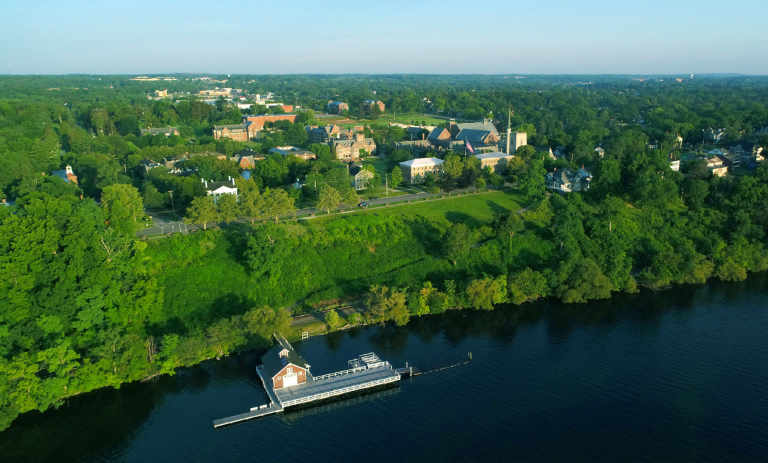
Lives of Consequence
Jeffrey L. Amestoy '68, P'11, P'14

38th Chief Justice of Vermont’s Supreme Court
When Jeffrey L. Amestoy ’68, P’11, P’14 authored the 1999 Vermont Supreme Court’s opinion in Baker v. State, which held that same-sex couples were constitutionally entitled to the rights and benefits of marriage, a New York Times profile of the then-chief justice read, “as a judge in an ongoing case, Amestoy cannot discuss the decision that makes him such a pivotal figure in Vermont.” Now, he can say, “I am grateful that I was able to contribute to a decision that advanced human rights.”
The 38th Chief Justice of Vermont’s Supreme Court from 1997 to 2004, Amestoy also served seven terms as Attorney General of Vermont and held the position of president of the National Association of Attorneys General from 1992 to 1993.
Born and raised in Vermont, Amestoy arrived on the HWS campus interested in political science. “I’ve been extraordinarily fortunate in my legal career and Hobart prepared me for a life of public service,” he says adding that he came to the right place.
“It was a time of social unrest and I was struck by the fact that when I arrived in 1964, freshman had to wear beanies and if you were stopped, you had to sing the school song,” he says. “By 1968, that was considered inconceivable.”
When Amestoy graduated from Hobart and was preparing to enter law school, he was drafted. After serving six months in the U.S. Army Reserve, he headed for Hasting College of Law at The University of California, San Francisco. After receiving his law degree, he returned to Vermont, where he began his career as an Assistant Attorney General.
“I started prosecuting white collar crime,” he says. “In 1981 I went to the Kennedy School for a year and got a master’s in public administration.” Afterward, he accepted an offer to become Vermont’s Commissioner of Labor and Industry, a position he held until resigning in 1984 to run for State Attorney General. He was elected to a two-year term -- and reelected six times in the years that followed.
In 1996, he was nominated by then-Governor Howard Dean to be Chief Justice of the Vermont Supreme Court, was confirmed by the Senate and took office in 1997, serving until 2004. It was during his time as Chief Justice that the issue of equality for same-sex couples arose in Vermont. In 1994, the landmark case, Baker v. State, led to a 1999 State Supreme Court decision Amestoy authored. The decision held that same-sex couples were entitled to the rights and benefits of marriage. It was, at the time, almost unheard of.
“There wasn’t much talk of the need for equal rights for same-sex couples before the ruling,” Amestoy says. “Gay rights organizations, including individuals active in Vermont, were working for recognition of same-sex couples but in 1998, there were only two states that had courts that even attempted to recognize same-sex relationships. One was in Hawaii, in which their Supreme Court recognized same-sex marriage and it was almost immediately overturned by popular vote. And in Alaska, a court ruled for same-sex marriage and then in a constitutional amendment overruled it. So on the legal front, there hadn’t been any successes.”
After the ruling, Vermont was the first state to institute civil unions for same-sex couples -- a controversial policy at the time. There were calls for Amestoy’s impeachment.
Baker v. State sparked a national conversation that has led to monumental change. “One of the consequences of the decision was it was an enormous contribution to the public dialogue,” says Amestoy. “It demonstrated to the rest of the country that it was possible to discuss the issue in ways that were civil and constructive. One of the contributions the language of this decision could make was to frame the discussion in human terms while providing a legal structure. It was important to set the context of the discussion in terms that relate to human rights.”
Amestoy says one often-cited phrase from his opinion allowed Vermonters to see the issue in terms that were meaningful to them.
“The extension of the Common Benefits Clause,” Amestoy wrote, “to acknowledge plaintiffs as Vermonters who seek nothing more, nor less, than legal protection and security for their avowed commitment to an intimate and lasting human relationship is simply, when all is said and done, a recognition of our common humanity.”
When “people began to discuss the issue in human terms,” Amestoy says, it opened doors for marriage equality from coast to coast.
In 2015, Amestoy published “Slavish Shore: The Odyssey of Richard Henry Dana Jr.,” the first full-lengthy biography of the 19th-century author, seaman, social justice activist and perhaps first civil rights lawyer. In “Slavish Shore,” Amestoy details the trajectory of Dana’s life, his career as a lawyer and his journey to become one of America’s most zealous champions of freedom and human dignity -- from his defense of fugitive slave Anthony Burns, to justifying President Abraham Lincoln’s war powers before the Supreme Court, to prosecuting Confederate President Jefferson Davis for treason. For his commitment to civil rights, Dana received an honorary degree from Hobart College in 1853.
In April 2014, Amestoy, the father of three -- two of whom are William Smith graduates -- was bestowed the Hobart Medal of Excellence, the Alumni Association’s highest honor, for his successful and influential career as a lawyer, Attorney General, and Chief Justice.
